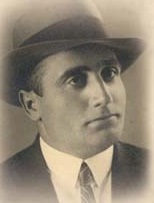Vlado Chernozemski
Vlado Chernozemski | |
|---|---|
 | |
| Born | October 19, 1897 |
| Died | October 9, 1934 (aged 36) |
| Nationality | Bulgarian |
Vlado Chernozemski (October 19, 1897 - October 9, 1934), born Velichko Dimitrov Kerin (Template:Lang-bg), was a Bulgarian revolutionary.[1][2] He was born in the village of Kamenitsa (now part of Velingrad). He joined the Internal Macedonian Revolutionary Organization (IMRO) in 1922. After killing Dimo Hadjidimov, leader of Bulgarian Communist Party in 1924 he was sentenced to death in 1928, but was granted an amnesty in 1932. He also murdered another member of the left wing of IMRO in 1930 on the order of Ivan Mihaylov.
Chernozemski also entered the region of Vardar Macedonia with IMRO bands and participated in more than 15 battles with the Serbian police. At one point, Chernozemski planned to enter the League of Nations building in Paris and detonate himself to protest against the passivity of the world organization over the question of independence for the Bulgarians in Macedonia but never carried out the plot[citation needed]. He assassinated Alexander I of Yugoslavia in the port of Marseille, France on October 9, 1934,[3] and was himself killed immediately afterwards, 10 days before his 37th birthday. He was also thought to have shot and killed French Foreign Minister Louis Barthou until 1974, when it was revealed that the bullet actually came from a French policeman reacting to the shooting of King Alexander[citation needed].
References
- ^ Митре Стаменов. „Атентатът в Марсилия. Владо Черноземски. Живот, отдаден на Македония“,(Издание на ВМРО-СМД, София, 1993)
- ^ Марсејскиот атентат - Цане Ѓорѓиевски
- ^ Rothschild, Joseph (1959). The Communist Party of Bulgaria; Origins and Development, 1883-1936. Columbia University Press. pp. 277–278.
